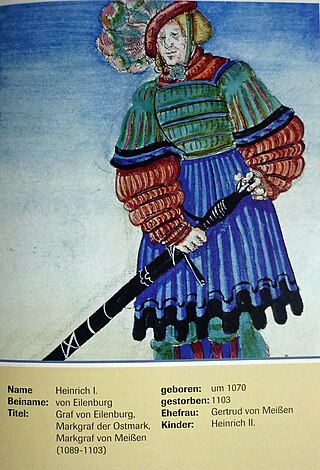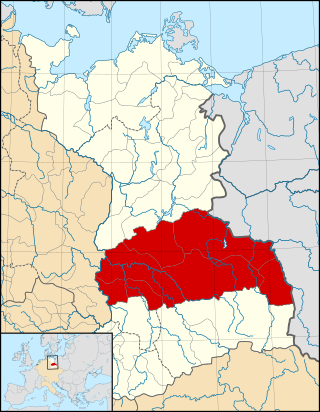Related Research Articles

The Congress of Gniezno was an amicable meeting between the Polish Duke Bolesław I the Brave and Emperor Otto III, which took place at Gniezno in Poland on 11 March 1000. Scholars disagree over the details of the decisions made at the convention, especially whether the ruler of Poland was pledged the king's crown or not.

The Margravate or Margraviate of Meissen was a medieval principality in the area of the modern German state of Saxony. It originally was a frontier march of the Holy Roman Empire, created out of the vast Marca Geronis in 965. Under the rule of the Wettin dynasty, the margravate finally merged with the former Duchy of Saxe-Wittenberg into the Saxon Electorate by 1423.

Henry I (1070–1103), nicknamed the Old, a member of the House of Wettin, was Count of Eilenburg as well as Margrave of the Saxon Eastern March from 1081 and Margrave of Meissen from 1089 until his death.

The Diocese of Dresden–Meissen is a Latin Church diocese of Catholic Church in Germany with its seat in Dresden. It is suffragan to the Archdiocese of Berlin.
The Bishopric of Merseburg was an episcopal see on the eastern border of the medieval Duchy of Saxony with its centre in Merseburg, where Merseburg Cathedral was constructed. The see was founded in 967 by Emperor Otto I at the same time in the same manner as those of Meissen and Zeitz, all suffragan dioceses of the Archbishopric of Magdeburg as part of a plan to bind the adjacent Slavic ("Wendish") lands in the Saxon Eastern March beyond the Saale River more closely to the Holy Roman Empire.

The Saxon Eastern March was a march of the Holy Roman Empire from the 10th until the 12th century. The term "eastern march" stems from the Latin term marchia Orientalis and originally could refer to either a march created on the eastern frontier of the East Frankish duchy of Saxony or another on the eastern border of the Duchy of Bavaria: the Bavarian marchia Orientalis, corresponding to later Austria.
Conrad I, called the Great, a member of the House of Wettin, was Margrave of Meissen from 1123 and Margrave of Lusatia from 1136 until his retirement in 1156. Initially a Saxon count, he became the ruler over large Imperial estates in the Eastern March and progenitor of the Saxon electors and kings.
Gisilher, Gisiler or Giseler was the second Archbishop of Magdeburg, succeeding Saint Adalbert, from 981 until his death in 1004.

The March or Margraviate of Lusatia was an eastern border march of the Holy Roman Empire in the lands settled by Polabian Slavs. It arose in 965 in the course of the partition of the vast Marca Geronis. Ruled by several Saxon margravial dynasties, among them the House of Wettin, the lordship was contested by the Polish kings as well as by the Ascanian margraves of Brandenburg. The remaining territory was finally incorporated into the Lands of the Bohemian Crown in 1367.
Dedi was the Margrave of the Saxon Ostmark from 1046 and a claimant for the title of Margrave of Meissen from 1069. He was the second son of Dietrich II of Wettin and Matilda, daughter of Eckard I of Meissen.
Otto I was the Margrave of Meissen from 1062 until his death in 1067, and the second Margrave of the family of the counts of Weimar and Orlamünde. He was a younger son of William III of Weimar and Oda, daughter of Thietmar, Margrave of the Saxon Ostmark. He inherited Orlamünde from his father in 1039 and Weimar from his brother William in 1062. He was appointed by the Emperor Henry IV to succeed William in Meissen as well. He became Advocate of the Cathedral of Merseburg in 1066.

Theodoric I, a member of the House of Wettin, was Margrave of Lusatia from 1156 until his death.
Otto II, the Rich, a member of the House of Wettin, was Margrave of Meissen from 1156 until his death.

Thimo I, Count of Wettin, a member of the Wettin dynasty, was Count of Wettin and Brehna.
Dietrich II was Margrave of Lusatia from 1032 to 1034, the first of the Wettin dynasty.

Henry II, also known as Saint Henry, Obl. S. B., was Holy Roman Emperor from 1014. He died without an heir in 1024, and was the last ruler of the Ottonian line. As Duke of Bavaria, appointed in 995, Henry became King of the Romans following the sudden death of his second cousin, Emperor Otto III in 1002, was made King of Italy in 1004, and crowned emperor by Pope Benedict VIII in 1014.

The German–Polish War consisted of a series of struggles in 1003–1018, between the Ottonian king Henry II of Germany and the Polish Piast ruler Bolesław I the Brave. The locus of conflict was the control of Lusatia, Upper Lusatia, as well as Bohemia, Moravia and Slovakia. The fighting ended with the Peace of Bautzen in 1018, which left Lusatia and Upper Lusatia as a fief of Poland, and Bohemia became a duchy in the Holy Roman Empire.

Dedi III, nicknamed the Fat, a member of the House of Wettin, was Margrave of Lusatia from 1185 until his death.
Adela of Louvain (d.1083) was margravine of Meissen and later, margravine of the Saxon Ostmark.
References
- 1 2 3 4 5 Eduard Machatschek: Geschichte der Bischöfe des Hochstiftes Meissen in chronologischer Reihenfolge (...) (pp. 103–111). Dresden 1884
- ↑ "Der Dom zu Meissen". Archived from the original on 2020-02-29. Retrieved 2017-01-14.